 Free technical library
Free technical library
Ball between fingers. Tips for a magician

Directory / Spectacular tricks and their clues
 Comments on the article
Comments on the article
Focus Description:
The ball quickly rolls from finger to finger, and the audience is delighted with your exceptional dexterity. This trick can only be mastered through hard and long practice, so be prepared to spend a lot of time getting your hands used to the ball and your fingers can make a series of movements in a certain sequence.
Having worked out the basic movements, you will see that further manipulation will be easier and easier for you. Practice and you will master the techniques that you will be justly proud of.
Focus secret:
1. Start rolling the ball in your fingers by taking the ball with the thumb and forefinger of your right hand, with the brush facing the audience with the back. Place your middle finger under the ball (but not touching the ball) to the right until it touches your thumb.
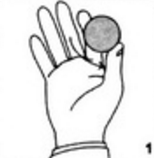
2. Now grab the ball between your index and middle fingers and your thumb releases it.

3. The ball is held by the index and middle fingers. Move your middle finger to the left, rolling the ball onto your index finger. At the same time, the ring finger moves to the right to the index finger. The ring finger of the ball has not yet touched.

4. Bend your index finger to the left, rolling the ball until it touches the tip of your ring finger. You are now holding the ball between your middle and ring fingers. Remove your index finger from the ball.

5. Holding the ball between the middle and ring fingers, bend the middle finger to the left in the same way as you curled the index finger in step 4. At the same time, move the little finger to the right and under the ball, but do not touch it yet.
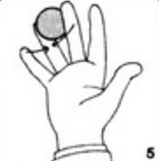
6. Continue to bend your middle finger to the left until you touch it with the tip of your little finger. Pinch the ball between your ring finger and little finger and release the ball with your middle finger.

7. Now the ball is sandwiched between the ring finger and the little finger. You circle the ball around the ring finger with your little finger, winding it up behind this finger. The ball rolls onto the back of the ring finger.

8. Continue to move the little finger around and behind the ring finger. Place the middle finger behind the ring finger and behind the ball until you pinch the ball between the ring and middle fingers so that the ball lies on the back of the ring finger. Once the ball is between your middle and ring fingers, release the ball with your little finger.
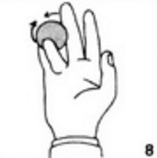
9. Now the ball is held by the middle and ring fingers on the back of the hand. Arch your ring finger to the right, rolling the ball around and behind your middle finger. The index finger moves to the left behind the ball and behind the middle finger, but does not yet touch the ball.

10. Continue rolling the ball with your ring finger around and behind your middle finger until the tips of your ring and index fingers touch. Then pinch the ball with the tips of your index and middle fingers and release the ball with your ring finger.
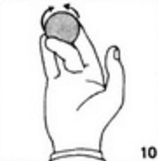
11. You are now holding the ball with the tips of your index and middle fingers. You rolled the ball over all fingers, that is, you successfully completed the Manipulation - the ball between the fingers. The ball rolled down the front side, around the ring finger, and then down the back to where it is now.
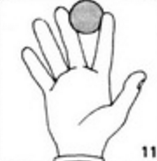
12. Now repeat steps 3 to 10 at a fast pace several times, demonstrating your skill.
13. Note. After step 11, do not use your thumb. The ball rolls between the index and middle fingers (around the middle finger) and starts on the return journey.
Manipulation will seem difficult at first, maybe even impossible. Do not give up. Try different sizes of balloons until you find the one that fits your hand best. (Rubber balls are easier to master, and sponge balls are easier than all others.) Carry a ball with you and practice constantly, wherever possible, and I bet you will master the manipulation - a ball between your fingers, and at a professional level, much faster, what you thought at first.
Author: Mark Wilson
 We recommend interesting articles Section Spectacular tricks and their clues:
We recommend interesting articles Section Spectacular tricks and their clues:
▪ wonderful box
▪ Card session (multiple tricks)
▪ Prediction of a stack of cards
 See other articles Section Spectacular tricks and their clues.
See other articles Section Spectacular tricks and their clues.
 Read and write useful comments on this article.
Read and write useful comments on this article.
<< Back
 Latest news of science and technology, new electronics:
Latest news of science and technology, new electronics:
Air trap for insects
01.05.2024
Agriculture is one of the key sectors of the economy, and pest control is an integral part of this process. A team of scientists from the Indian Council of Agricultural Research-Central Potato Research Institute (ICAR-CPRI), Shimla, has come up with an innovative solution to this problem - a wind-powered insect air trap. This device addresses the shortcomings of traditional pest control methods by providing real-time insect population data. The trap is powered entirely by wind energy, making it an environmentally friendly solution that requires no power. Its unique design allows monitoring of both harmful and beneficial insects, providing a complete overview of the population in any agricultural area. “By assessing target pests at the right time, we can take necessary measures to control both pests and diseases,” says Kapil ... >>
The threat of space debris to the Earth's magnetic field
01.05.2024
More and more often we hear about an increase in the amount of space debris surrounding our planet. However, it is not only active satellites and spacecraft that contribute to this problem, but also debris from old missions. The growing number of satellites launched by companies like SpaceX creates not only opportunities for the development of the Internet, but also serious threats to space security. Experts are now turning their attention to the potential implications for the Earth's magnetic field. Dr. Jonathan McDowell of the Harvard-Smithsonian Center for Astrophysics emphasizes that companies are rapidly deploying satellite constellations, and the number of satellites could grow to 100 in the next decade. The rapid development of these cosmic armadas of satellites can lead to contamination of the Earth's plasma environment with dangerous debris and a threat to the stability of the magnetosphere. Metal debris from used rockets can disrupt the ionosphere and magnetosphere. Both of these systems play a key role in protecting the atmosphere and maintaining ... >>
Solidification of bulk substances
30.04.2024
There are quite a few mysteries in the world of science, and one of them is the strange behavior of bulk materials. They may behave like a solid but suddenly turn into a flowing liquid. This phenomenon has attracted the attention of many researchers, and we may finally be getting closer to solving this mystery. Imagine sand in an hourglass. It usually flows freely, but in some cases its particles begin to get stuck, turning from a liquid to a solid. This transition has important implications for many areas, from drug production to construction. Researchers from the USA have attempted to describe this phenomenon and come closer to understanding it. In the study, the scientists conducted simulations in the laboratory using data from bags of polystyrene beads. They found that the vibrations within these sets had specific frequencies, meaning that only certain types of vibrations could travel through the material. Received ... >>
 Random news from the Archive Random news from the Archive Heat resistant bioplastic
02.11.2020
Japanese scientists have created the most heat-resistant plastic using a special macromolecular design that was obtained from natural materials.
Most of the plastics we use on a daily basis are synthetic materials derived from petroleum. Many scientists have long been trying to come up with a replacement for plastic using more sustainable materials such as plants, eggshells, chicken feathers, etc.
These alternative ways of producing plastics could not only reduce humanity's dependence on fossil fuels, but also lead to more "environmentally friendly" materials, as they can degrade faster in natural conditions. But, unfortunately, to date, all alternatives are less durable and flexible than petroleum-based plastics. Therefore, Japanese scientists thought about a way to make a more durable and stable alternative.
Researchers from the Institute of Science and Technology and the University of Tokyo observed the sulphate process of turning wood into cellulose. During this wood processing method, scientists obtained two aromatic molecules called AHBA and ABA.
The scientists combined these molecules with recombinant microorganisms and some chemicals, turning them into polymers, which, in turn, could be easily processed into a heat-resistant film. The end product was a lightweight organic plastic that has the highest temperature resistance of any plastic known, as the material can withstand temperatures of over 740°C!
|
 Other interesting news:
Other interesting news:
▪ Nanotablets with micromotor
▪ Reflective paint cools sun-heated surfaces
▪ New FLUKE 87V Digital Multimeter
▪ False nails glow with mobile phone call
▪ Flexible Solar Panel for Boats
 News feed of science and technology, new electronics
News feed of science and technology, new electronics
 Interesting materials of the Free Technical Library:
Interesting materials of the Free Technical Library:
▪ section of the site Factory technology at home. Article selection
▪ article Hit the face in the dirt. Popular expression
▪ article Do snakes lay eggs? Detailed answer
▪ German medlar article. Legends, cultivation, methods of application
▪ article Low-frequency amplifier on the LA4555 chip. Encyclopedia of radio electronics and electrical engineering
▪ article Coordination EMF. Encyclopedia of radio electronics and electrical engineering
 Leave your comment on this article:
Leave your comment on this article:
 All languages of this page
All languages of this page
Home page | Library | Articles | Website map | Site Reviews

www.diagram.com.ua
2000-2024







 Arabic
Arabic Bengali
Bengali Chinese
Chinese English
English French
French German
German Hebrew
Hebrew Hindi
Hindi Italian
Italian Japanese
Japanese Korean
Korean Malay
Malay Polish
Polish Portuguese
Portuguese Spanish
Spanish Turkish
Turkish Ukrainian
Ukrainian Vietnamese
Vietnamese












 See other articles Section
See other articles Section 